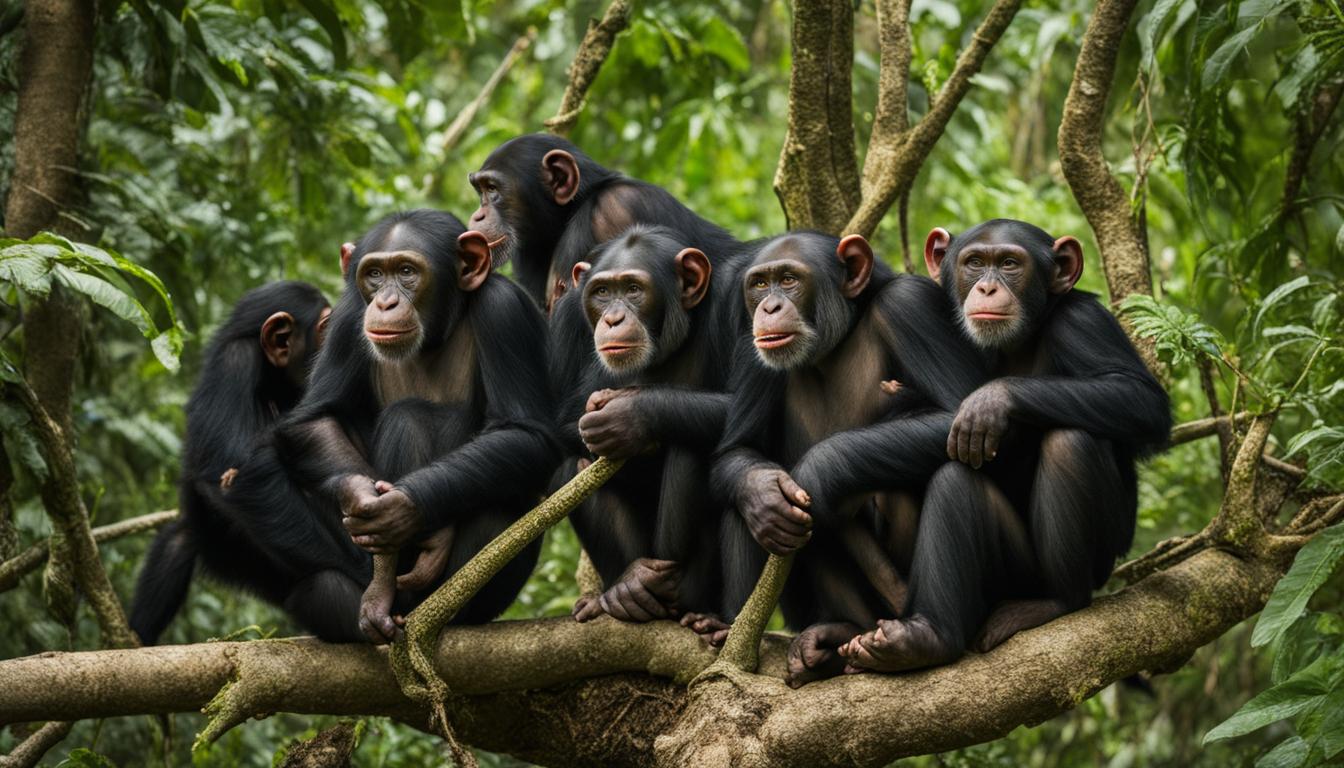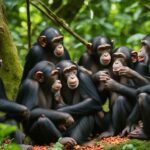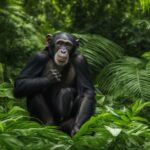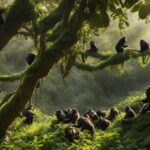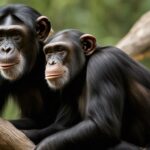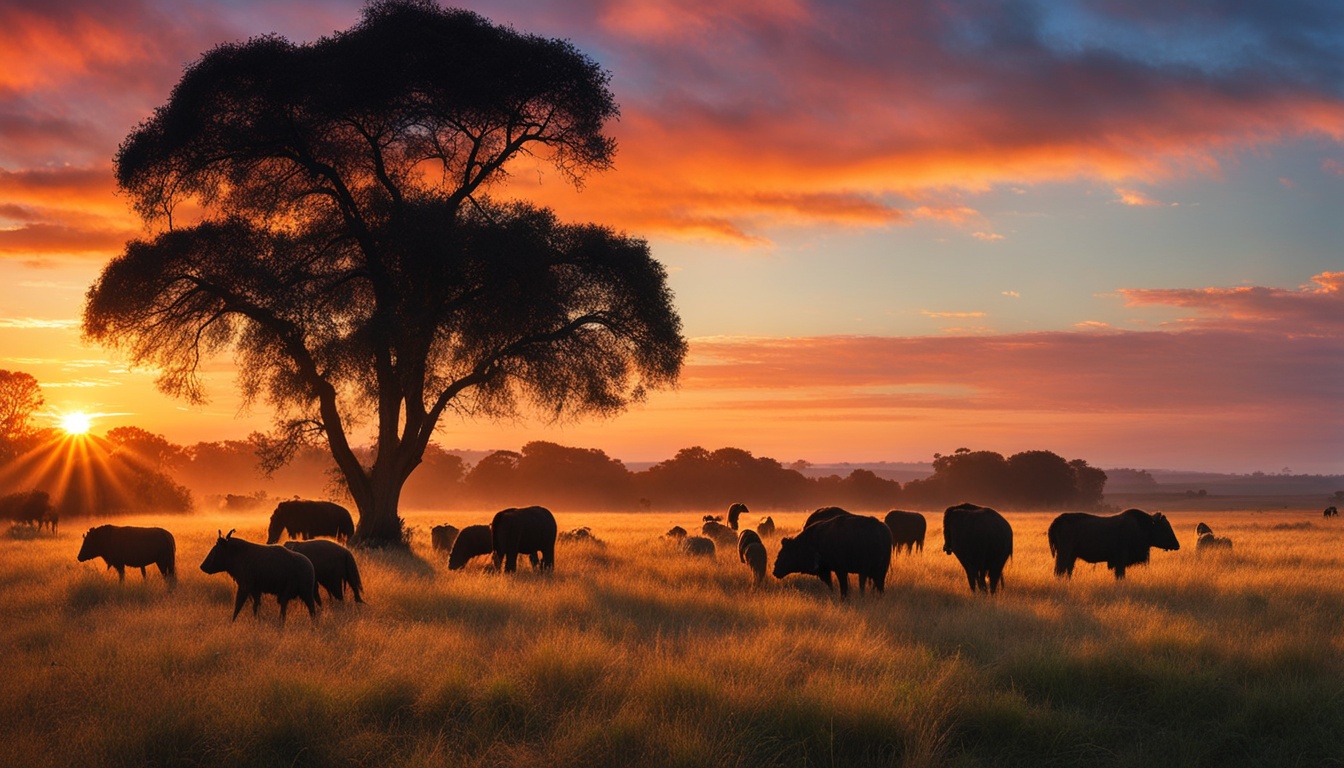Chimpanzees, our close relatives, face numerous threats to their survival. The primary challenges include habitat loss, disease, and hunting, particularly for bushmeat. These threats are intensified by the slow reproductive rate of chimpanzees, making it difficult for their populations to recover. Habitat destruction, driven by factors such as deforestation and land-use changes, is a significant threat. Illegal hunting and the bushmeat trade also contribute to their decline. Additionally, human-wildlife conflict, poaching, and the effects of climate change further jeopardize the survival of wild chimpanzee populations.
The Role of Chimpanzees in the Ecosystem
Chimpanzees, as one of the key species in Central Africa’s forests, play a vital role in maintaining the balance and diversity of their ecosystems. One of the significant contributions they make is seed dispersal. Chimpanzees consume a variety of fruits and nuts, and as they move through the forest, they excrete the undigested seeds in different locations. This seed dispersal behavior is crucial for the regeneration and growth of plant species, as it helps to spread the seeds far and wide, promoting forest diversity.
The importance of chimpanzees in seed dispersal can be seen in the impact they have on the distribution and abundance of certain plant species. A study conducted in Uganda’s Kibale National Park found that the seeds of the large-fruited trees eaten by chimpanzees were more likely to germinate and establish in areas that had been visited by these primates. This highlights the critical role chimpanzees play in shaping the composition and structure of their forest habitats.
| Table: Examples of Plants Dispersed by Chimpanzees | Seed Dispersal Mechanism |
|---|---|
| Fig Trees (Ficus spp.) | Chimpanzees consume the fruit and disperse seeds through their feces. |
| Nut Trees (Dacryodes spp.) | Chimpanzees crack open the nuts to access the edible portion, leaving behind intact seeds. |
| Saba senegalensis | Chimpanzees feed on the fleshy pulp of the fruit and disperse the seeds through their feces. |
Furthermore, the movements and foraging behaviors of chimpanzees also influence the distribution and diversity of other animal species within their ecosystems. As they search for food, chimpanzees create pathways and open up understory vegetation, which benefits smaller primates, such as monkeys, by providing them access to food resources and creating new habitats.
The Interconnection of Species in Forest Ecosystems
The interdependency of species within forest ecosystems is a delicate balance, with each organism playing a crucial role. Chimpanzees, as seed dispersers, contribute to the overall health and functioning of the ecosystem. Their activities help maintain the genetic diversity of plant populations, ensuring their resilience in the face of environmental challenges. By preserving chimpanzee populations and protecting their habitats, we are not only safeguarding these remarkable creatures but also safeguarding the biodiversity and stability of the forests they call home.
The Social Structure and Behavior of Chimpanzees
Chimpanzees, our closest relatives in the animal kingdom, exhibit fascinating social structures and behaviors. They form communities led by dominant males, with both males and females living together in loose and flexible groups. These communities are characterized by individuals joining and leaving based on reproductive status and resource availability. Such fluid social dynamics enable chimpanzees to adapt to changing environmental conditions and ensure the survival of their species.
One of the most important aspects of chimpanzee socialization is their grooming behavior. Grooming serves multiple purposes, such as maintaining hygiene and forming strong social bonds within the community. Chimpanzees spend hours grooming each other, not only removing dirt and parasites but also promoting social cohesion and reducing conflict. This behavior demonstrates their ability to communicate and establish relationships, highlighting their complex social intelligence.
Communication is another crucial aspect of chimpanzee social structure. They communicate through a combination of vocalizations, facial expressions, and body postures. These forms of communication play a vital role in sharing information, establishing social hierarchies, and resolving conflicts within their communities. Chimpanzees possess a rich repertoire of vocalizations that allow them to convey various messages, such as warning calls, greeting sounds, and expressions of distress or excitement. Their ability to communicate effectively contributes to the overall cohesion and functioning of chimpanzee communities.
Chimpanzee Intelligence and Problem-Solving Abilities
In addition to their complex social behaviors, chimpanzees are renowned for their intelligence and problem-solving abilities. They have been observed using tools in their daily activities, such as using sticks to extract termites from mounds or rocks to crack open nuts. This tool use showcases their ability to adapt and innovate in order to meet their needs. Chimpanzees also possess a remarkable capacity for problem-solving, as demonstrated in various experiments that require them to navigate through complex puzzles or retrieve food using creative techniques. Their cognitive abilities highlight the impressive level of intelligence present in these primates.
In summary, chimpanzees exhibit intricate social structures and a wide range of behaviors that contribute to their survival as a species. Their flexible social groups, grooming behavior, and communication skills create a cohesive and adaptable community. Additionally, their intelligence and problem-solving abilities allow them to navigate their environment successfully. Understanding and appreciating the social structure and behavior of chimpanzees is essential for the conservation and preservation of these remarkable creatures.
Conservation Efforts for Chimpanzee Protection
Conservation organizations, governments, and local communities are actively working together to protect chimpanzees and ensure their survival in the wild. These efforts encompass various strategies aimed at mitigating the primary threats faced by these endangered primates. One crucial initiative involves the development of IUCN Action Plans, which serve as comprehensive blueprints for chimpanzee conservation. These action plans are created through collaborations between non-governmental organizations (NGOs) and national governments, highlighting the global commitment to safeguarding these remarkable creatures.
Wildlife protection plays a vital role in chimpanzee conservation. Direct engagement with protected area authorities and their game guards helps enforce anti-poaching measures and prevent illegal hunting. By establishing and maintaining protected areas specifically designated for chimpanzees, their habitats and populations can be better safeguarded from encroachment and human-wildlife conflicts. Additionally, increased efforts to combat the bushmeat trade, a significant threat to chimpanzees, are being undertaken through the implementation of stricter law enforcement and monitoring.
Environmental education programs are also being implemented to raise awareness about the importance of chimpanzee conservation. These programs target both children and adults, providing them with knowledge about the vulnerability of chimpanzee populations and the role they play in maintaining ecosystem balance. By promoting a deeper understanding of the value and significance of these primates, environmental education efforts aim to foster a sense of stewardship among communities and inspire actions that contribute to their protection.
| Conservation Effort | Description |
|---|---|
| IUCN Action Plans | Comprehensive blueprints for chimpanzee conservation developed through collaborations between NGOs and national governments. |
| Wildlife Protection | Direct engagement with protected area authorities and game guards to enforce anti-poaching measures and prevent illegal hunting. |
| Environmental Education | Implementation of programs to raise awareness about chimpanzee conservation and their ecological importance among children and adults. |
| Land Use Planning | Collaboration with national governments and logging concessions to improve land use planning and combat habitat loss. |
Efforts are also being made to improve land use planning and combat habitat loss. Collaboration with national governments and logging concessions is essential in ensuring that land-use decisions take into account the protection of chimpanzee habitats. By advocating for sustainable practices and responsible land management, conservation organizations aim to minimize the adverse effects of deforestation and habitat destruction on chimpanzee populations and their ecosystems.
In summary, the conservation efforts for chimpanzee protection are multifaceted and involve a range of stakeholders. Through the development of IUCN Action Plans, wildlife protection measures, environmental education programs, and improved land use planning, significant progress is being made in safeguarding these endangered primates. By supporting and actively participating in these initiatives, we can contribute to the conservation of chimpanzees and help secure a brighter future for these incredible creatures.
Conclusion
Chimpanzees face significant threats to their existence, including habitat loss, disease, hunting, and the impacts of climate change. Protecting and conserving these charismatic species is crucial for maintaining the diversity of Central Africa’s forests and the balance of their ecosystems.
Conservation efforts, such as the development of action plans, wildlife protection, environmental education, and sustainable land use planning, are essential for securing the future of wild chimpanzee populations. By supporting these initiatives, you can contribute to their conservation and ensure a brighter future for these endangered primates.
With increasing awareness and collective action, we can make a positive impact on the survival of chimpanzees. It is important to recognize the importance of their role in the ecosystem and the need to protect their habitats. By advocating for stronger regulations, supporting conservation organizations, and promoting sustainable practices, we can help mitigate the threats faced by wild chimpanzee populations.
Together, we can ensure that future generations get to experience the wonder of chimpanzees in their natural habitats. Let’s work towards a world where these incredible creatures can thrive, where their forests remain healthy and diverse, and where the balance of ecosystems is preserved.
What are the primary threats facing wild chimpanzee populations?
The primary threats facing wild chimpanzee populations include habitat loss due to deforestation, hunting and poaching for bushmeat and illegal pet trade, and disease transmission from humans and domestic animals. These factors have led to a decline in chimpanzee numbers and put the species at risk of extinction.
FAQ
What are the primary threats facing wild chimpanzee populations?
Chimpanzees face numerous threats to their survival, including habitat loss, disease, and hunting, particularly for bushmeat. These threats are intensified by the slow reproductive rate of chimpanzees, making it difficult for their populations to recover. Habitat destruction, driven by factors such as deforestation and land-use changes, is a significant threat. Illegal hunting and the bushmeat trade also contribute to their decline. Additionally, human-wildlife conflict, poaching, and the effects of climate change further jeopardize the survival of wild chimpanzee populations.
What is the role of chimpanzees in the ecosystem?
Chimpanzees play a crucial role in maintaining the diversity of Central Africa’s forests. They eat and disperse large seeds that other animals cannot consume. Without chimpanzees, along with other great apes and elephants, these forests would undergo irreversible changes. Their feeding activities help disperse seeds, contributing to the growth and regeneration of plant species. Furthermore, their movements and foraging behaviors influence the distribution and diversity of other animal species within their ecosystems.
What is the social structure and behavior of chimpanzees?
Chimpanzees are highly social animals with complex social structures. They live in communities consisting of males and females led by a dominant male. These communities are characterized by loose and flexible groups, with individuals joining and leaving based on reproductive status and resource availability. Chimpanzees engage in various social behaviors, such as grooming and cleaning each other, which helps form strong bonds. They communicate using vocalizations, facial expressions, and body postures, which play a vital role in sharing information, establishing social hierarchies, and resolving conflicts. Chimpanzees are also known for their intelligence and remarkable problem-solving abilities, as they have been observed using tools to aid in their daily activities.
What conservation efforts are being made to protect chimpanzees?
Conservation organizations, governments, and local communities are working together to protect chimpanzees. Efforts include the development of IUCN Action Plans through collaborations with NGOs and national governments. Wildlife protection is enhanced through direct engagement with protected area authorities and their game guards. Environmental education programs are being implemented to raise awareness among both children and adults about the vulnerability of chimpanzees to hunting. Conservation initiatives also involve working with national governments and logging concessions to improve land use planning and combat habitat loss.

